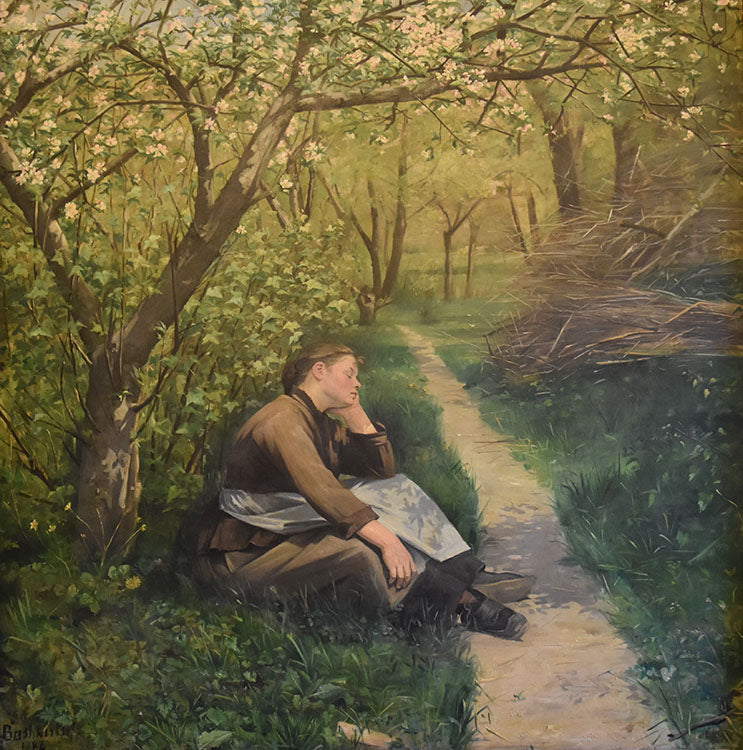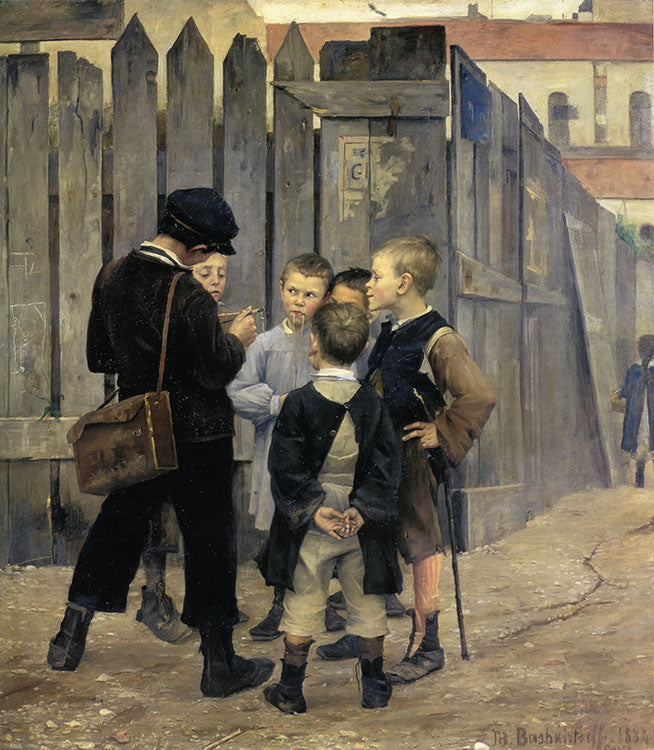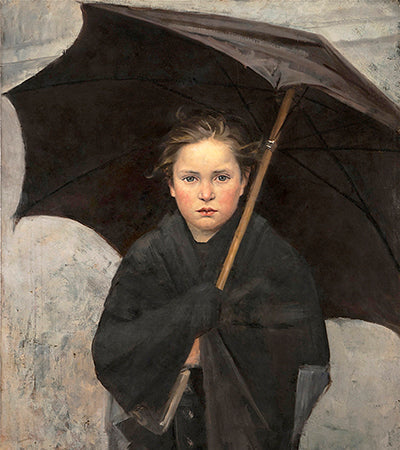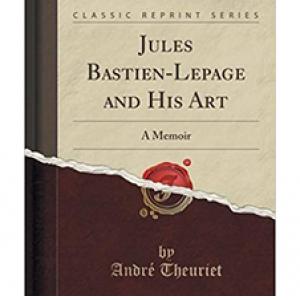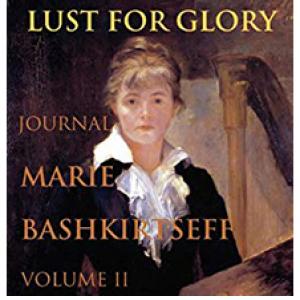The Life and Passions of Marie Bashkirtseff
by Cathy Locke

“Spring,” 1884, oil on canvas, Russian Museum, St. Petersburg, Russia
I often feel that my artistic career is made up of nothing but bread crumbs that I follow around for years and years. These small morsels of information lead me on a variety of paths that on rare occasion actually piece together in the most interesting ways.
For the last decade I have been leading art tours in Russia. In order to prepare for these tours, I visit all the museums where I am going to lecture prior to the beginning of the tour. In June 2012, I was in St. Petersburg walking the halls of the Russian Museum, famous for Russian paintings, when I spotted a painting that I was sure had been created by the French artist Jules Bastien-Lepage (1848-1884). With my curiosity piqued I leaned forward to read the plaque next to the painting – Spring (1884) by Marie Bashkirtseff (1858-1884). My eyebrows crinkled, I walked back to take another look. Square format like Bastien-Lepage’s famous series – check. Portrait of a peasant in a rural environment – check – just like a Bastien-Lepage. It was a lovely painting of a young woman resting under the blossoms of an apple tree with a path leading off to eternity. Upon my return home I discovered that Marie Bashkirtseff began keeping a journal at the age of fifteen, in 1873, often writing in it daily until her death eleven years later, in 1884. After her death, her mother (also named Marie) had it published by André Theuriet (1833-1907), the same guy who published a book on Bastien-Lepage. Of course, I immediately began reading I Am the Most Interesting Book of All: The Diary of Marie Bashkirtseff. It portrays a young girl of high society growing up in a privileged life style. She was opinionated, spoiled and quick-tempered. Bashkirtseff’s life centered around aspirations of becoming a famous opera singer, flirtations with various marriage proposals and a frustration with the limits placed on her for having been born female. But, how did she know Bastien-Lepage?
In 2013, with all the best intentions of studying the life work of Bastien-Lepage and writing an article on him, I bought Theuriet’s book Jules Bastien-Lepage and His Art. The book sat in my office collecting dust for years until I could no longer handle the neglect. So, it was in 2018 that I decided to read it. Though the use of the English language was nearly two hundred years old, the book did give me a basic blueprint of the artist’s work, but not much of who he was as a person. At the end of this book there is a chapter on Bashkirtseff, another breadcrumb. I decided to see if there might be another book on her. It was then that I discovered that there are two volumes of her journal. I had read Volume I, outlining her as a preteen, but it was Volume II, Lust and Glory, that outlined her life as an artist in Paris. I flew through Volume II, never wanting to put it down. At last I discovered who she was and her love for Jules Bastien-Lepage. These two artists became more than Bashkirtseff and Bastien-Lepage, they came alive as Marie and Jules.
"The artist is nothing without the gift, but the gift is nothing without work."
– Emile Zola
Marie Konstantinova Bashkirtseff was born on November 24, 1858, into a family of lower nobility near Poltava, in an area that is now in the Ukraine. Her parents maintained a love-hate relationship throughout the artist’s life. Though they separated when she was just two years old, they remained married and visited frequently. Her mother traveled throughout Europe in an effort to distance herself from her husband and as a result, Marie spent extended periods living in Italy and Paris. Early in her journal, she remarked about the disadvantages of being a woman. “She complained about the educational and economic limitations imposed on women, even on those of the upper classes. As an ambitious woman, Marie looked for various avenues to attain fame; becoming a great singer or a great artist both appealed to her.”1 She was educated privately and had an early musical talent comprising of a superb operattic voice and the ability to play the mandolin, harp and piano. In 1877 she was diagnosed with chronic laryngitis, which ruined her voice, ending any hopes of a singing career. Certain that fame was the only way she could achieve independence as a woman and be free of marriage, Marie decided to become an artist and began studying at the only school that would teach women, Académie Julian in Paris. It was there that Marie was able to develop a name for herself and become more independent of her family. While living in Paris she joined the French women’s rights movement and published articles under a pseudonym. Throughout her journal entries Marie writes about her struggles to assert herself as a strong-minded independent woman.

By 1879, at the age of twenty-one, Marie was working full time as a student directly under Rodolphe Julian (1839–1907)and Tony Robert-Fleury (1837-1911). On Tuesday, May 6, 1879 Marie writes in her diary – “For three weeks I’ve been working from 8 to noon and from 2 to 5, coming home at 5:30; after that I work until 7:00. Then I do a few sketches or some reading or a little music. By 10:00 I’m ready to go to bed. This existence keeps me from thinking that life is short and that my youth is spent in front of an easel or a book.” She was a gifted student and her talent developed fast. Early in 1879 she won a medal at her school’s competition that was judged by Jules Lefebvre (1836-1911) and Tony Robert-Fleury. Toward the end of that year she writes, “Art! …when have you seen a celebrity appear after only 2 years of study? Art will give me a place when I’m 28 or 30 years old because all these great little-known men commenced their studies at 14 or 17.” It was also in 1879 when Marie was first introduced to the work of Jules Bastien-Lepage when he won the Legion of Honor at the Paris Salon.

In 1880, her painting Question du Divorce was accepted into the Paris Salon. She signed it“Russ” (for Russian), so that the judges would not know she was a woman. On Friday, April 30, 1880 Marie went to see her painting at the Salon and also saw Bastien-Lepage’s Joan of Arc. She writes, “…Joan of Arc… is perfection. Her head turned to one side, her neck arched, and her great clear eyes that look at nothing; the head creates an extraordinary effect.” Marie naturally made her way into the lives of the artists' community in Paris. She enchanted her teachers Julian and Tony, whom she was on a first named basis, and regularly had them over for dinner. She socialized with Carlous-Duran (1837-1917), who sang songs at her social gatherings, and Mihály Munkácsy (1844 – 1900), whose wife she thought was ugly. She admired Diego Velázquez (1599-1660), read the works of Emile Zola (1840-1902) nightly, and loved Portrait of Madame X (1884) by John Singer Sargent (1856-1925). She knew Madame Gautereau (aka Madame X) and wrote, “For me it is the perfect painting–masterly, true. The beautiful lady is horrible in daylight because she uses too much makeup in spite of her 26 years. This chalky paint looks like plaster and gives her shoulders the hue of a corpse. Further, she paints her ears pink and her hair the color of mahogany. The eyebrows are traced in mahogany with heavy lines. She’s crazy or blind. But at night she is truly very beautiful.”
In 1880, on Christmas Eve, Rodolphe Julian suggested to Marie the idea of creating a painting of his studio for the Salon. The process of painting L’Atelier Julian was very difficult for Marie; the studio space was very small and her painting was large measuring 60” tall x 74” wide. At one point she had a fight with Julian over taking down a partition to open up the size of the studio. Initially, Julian made her pay for the construction, but later gave in. All together, Marie included fourteen fellow female students, a model and the school skeleton in the painting. On Saturday, March 19, 1881 Marie writes in her journal, “Julian is now furious (with himself) for having given me this amazing subject for a first assignment. ‘Well, Monsieur, let’s leave it for next year,’ where upon he looked at me, his eyes shining in the hope of finding me worthy and proud and capable of giving up the vain satisfaction of exhibiting an incomplete and mediocre thing. He would be delighted if I would give it up, and so would I. But what about the others – my friends? They would say that the professors didn’t like what I’ve done, that I’m not capable of doing a picture, and finally that my picture was refused. Question: Have I done everything I could do? Yes, certainly, but I found myself faced with completely unknown problems. Still, I’ve learned a great deal.”She signed the painting “Andrey” because it was a name that wasn’t female in French or Russian and it begins with an A, which would place her at the beginning of the judges list, making her fate known more quickly. The morning of May 6, 1881 she met Julian and Jules Lefebvre (1836-1911) at the Salon to see L’Atelier Julian hanging there and both men commented on its great qualities.
In the autumn of 1881, Marie’s health deteriorated, and her deafness increased; the same month, Dr. Fauvel examined her and found that her lungs were infected. Various doctors advised Marie to leave Paris and head south to a warmer climate. She resisted and worked more diligently on her art. She writes, “I cough so much that everything inside me must be damaged.” On January 12, 1882 her family gave a large lavish party to celebrate the Russian New Year. Marie invited Jules Bastien-Lepage, whom she greatly admired. On Saturday, January 21, 1882 she went to his home studio accompanied by a socialite Madame Cartwright. Marie writes, “We found two or three Americans there, and the little artist himself who is very small, very blonde, his hair cut Breton style, a turned-up nose, and an adolescent beard. He quite upset all my previous notions of what he would look like. I love his paintings, but it’s impossible to regard him as a master. I’d love to treat him like a comrade, yet his paintings hang there to fill you with admiration, alarm, and envy. There are 4 or 5 all life size and painted outdoors–quite beautiful. Bastien seems a good-natured little man, very content with himself. I was rubbing my hands on Bastien’s palette and he made me a gift of two brushes. I’ll plant them in my studio and a laurel tree will grow there.”

“The Umbrella”, 1883, oil on canvas, Russian Museum, St. Petersburg, Russia
By February 1882 Marie had begun her next masterpiece. She writes, “I’ve found my subject: 3 street children next to a double door–most realistic.” By August she had set up an arrangement with a local orphanage where she would begin a series of paintings of the children. On August 23 she writes, “I’ve been out walking, looking for pictures. I’ve gone twice to the orphanage. The director is already a friend, and the children crowded around me on the second visit for the bonbons I was handing out.” On Tuesday, August 29, 1882 Marie writes about working on her painting The Umbrella,“I’m painting a little girl with her black skirts over her shoulders and an open umbrella. I work outside and it rains constantly.” By the end of 1882 Jules and Marie were visiting each other regularly. On Thursday, December 14 she writes, “Jules brought back several studies, one of which is "Soir au Village." A man returns from the fields. He’s come to talk with a woman who faces the house with the lighted window. The evening light is marvelously done’ calm seeps into everything; people are heading home. Silence everywhere, except that you seem to hear a dog barking. It has such color, such poetry, such charm!” On December 17 she continues, “The true Bastien came today. I received him in panic, embarrassed and humiliated to have nothing to show him. He stayed more than two hours, looking at the pictures everywhere, but I was nervous and laughing.” By the end of that year Marie discovered she had tuberculous. Jules finished Village Lovers at the end of the year; by the time it was exhibited in the 1883 Paris Salon, he too was very sick.

Marie began another painting of two orphan boys, which she titled Jean et Jacques. Sunday, February 11, 1883: “I changed the canvas and started again. The painting took me two hours. The one I started Wednesday I’ve thrown away, and I started again yesterday. It shows 2 little boys going to school. They hold each other by the hand. I work outside in the courtyard of the orphanage in the open air, but well wrapped up.” Tuesday, February 27, 1883: “As for my picture, two little boys are walking along a sidewalk, holding each other by the hand. The elder, about 8, with a leaf between his teeth, is looking off into space ahead of him. The little one, about 4, with one hand in his pants’ pocket, looks out at the viewer of the picture. I don’t know what to think, but here I am again pleased with myself. It’s truly dreadful!” In March she entered the painting into the 1883 Paris Salon along with a pastel portrait. She nervously awaited the results, writing on Sunday, March 25, 1883: Alice arrived and said it was Julian who announced I had been accepted. ‘The pastel also?’ ‘No, but Irma’s head.’ Alice spent the night here. I arranged a bed for her and we talked about Bastien all night. I telegraphed Julian. I’ve not had an answer yet and it’s 3:00 in the afternoon. Here’s his telegram, exactly; ‘Accepted with a number 3 at least, but I know someone who wanted a number 2 for you. And now that you have conquered, greetings and felicitations.’” She ends up receiving an Honorable Mention medal for Jean et Jacques, awarded by Lefévre, William Bouguereau (1825-1905) and Tony, beating out 200 male students.

"The Meeting," 1884, oil on canvas, Musée d'Orsay, Paris, France
By Easter 1883 Marie had decided to paint six boys, life-size, standing on the street corner; the tallest, his back turned, holds a nest, while the others look on in various attitudes. Jules thought the concept was good but offered advice on the background. Saturday, May 12, 1883: “I spent the morning at the studio and begged Julian to come see the boys. He came to dinner. The canvas had to be brought from the orphanage. The boys, 6 of them, with the tall one seen from the back, showing them what he has in his hand. In the distance 2 or 3 little girls walking away. Julian insists I remove the street lamp in the left-hand corner. He’s right. He likes the rest and thinks it’s amusing, original, sure to have a success.” Her painting The Meeting was accepted into the 1884 Salon. At the opening she overheard someone say, “There’s a very good Bastien-Lepage in there signed Bashkirtseff.”

“Spring,” 1884, oil on canvas, Russian Museum, St. Petersburg, Russia
In May 1883 Marie started a decorative panel titled Spring which she describes as, “a young woman leaning against a tree, smiling, her eyes closed as if in a beautiful dream, and all around a delicate landscape tenderly green, pale roses, apple trees. I want the sun in it, and I’ll do it at Nice in an orchard, and if I can find a poetic orchard, the woman will be nude.” At the same time Marie tried to buy one of Jules’s paintings. “I have just written to M. Davis in America to ask if he wishes to sell Bastien’s Jeanne d’Arc. He stole it for only 20,000 francs. A month from now we’ll receive 36,000 rubles, and if the painting is not over 60,000 francs, I have decided to commit this folly. He bought it 3 years ago, and to double his money in that time ought to be sufficient even for an American.”
By July of 1884 Marie and Jules were seeing each other three times a week. Jules was quite sick, and Marie’s family was sending him Russian soup on a regular basis. By August Marie learned that he had cancer and was going to die. That same month Marie realizes she is dying and writes, “The rage of seeing yourself die! The end of all my miseries! So many aspirations, so many desires, so many projects–to die at the age of 25, just at the beginning of everything.” In September Jules told her, “No other woman, has had such a success as mine after so few years of work. Everyone knows you. It’s a true success!” Jules continued to come see her when she was too ill to go see him, installing an easy chair next to her. Monday, October 20th was the date of Marie’s last journal entry: “For the last two days my bed has been in the drawing room... It’s too difficult for me to go upstairs.” Marie died eleven days later on October 31 and Jules died six weeks later on December 10. Marie’s family hired Émile Bastien-Lepage, Jules’ brother, to organize the funeral and design a stone mausoleum.2 Jules' family took his body home to the village of Damvillers, where they planted an apple tree next to his grave.
I would like to think that in the spring, when the apple tree blossoms, that Marie’s spirit sits next to his grave.
– Prince Bojidar Karageorgevitch (1862-1908), a childhood friend, describe Bashkirtseff's last moments –
"Marie rises a bit, releases a soft sigh, the sigh of tiny children when waking, and two thick tears roll down her cheek....
then her head falls again into the pillow."3
Sources
1. Marie Bashkirtseff, Translated by Phyllis Howard Kernberger and Katherine Kernberger, I Am the Most Interesting Book of All: The Diary of Marie Bashkirtseff, Chronicle Books; 1st edition (June 1, 1997), page IX.
2. Émile Bastien-Lepage created a monument of a full-sized artist's studio that has been declared a historic monument by the government of France.
3. https://en.wikipedia.org/wiki/Prince_Bojidar_Karageorgevitch
Additional Sources
All excepts come from: Lust For Glory: Journal of Marie Bashkirtseff. Volume II, translation by Katherin Kernberger, Fonthill Press LLC 2013
André Theuriet, Jules Bastien-Lepage and His Art, Forgotten Books, 2012, Originally published in 1892
Additional Notes
Marie Bashkirtseff was included in the 2018 exhibition Women in Paris 1850-1900, organized by the American Federation of the Arts, and traveled to the following:
- Denver Art Museum, Denver, CO (October 22, 2017 to January 14, 2018)
- Speed Art Museum, Louisville, KY (February 17 to May 13, 2018)
- Clark Art Institute, Williamstown, MA (June 9 to September 3, 2018)
One year after their death in 1885, Marie Bashkirtseff’s mother purchased Annunciation to the Shepherds and Joan of Arc.(https://www.ngv.vic.gov.au/explore/collection/work/3767/)
About the Author

Cathy Locke’s artwork – www.cathylocke.com







